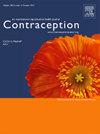醋酸乌普利司酮在紧急避孕之外的应用:叙述性回顾。
IF 2.3
2区 医学
Q1 OBSTETRICS & GYNECOLOGY
引用次数: 0
摘要
目的:醋酸Ulipristal (UPA)是一种选择性孕激素受体调节剂,也是美国最有效的口服EC方法。本综述的目的是识别和描述UPA在EC以外的用途,并进一步讨论有关可能的脱靶肝脏效应的问题。研究设计:我们于2024年8月使用Embase、Medline (PubMed)和Cochrane进行了文献检索,利用MeSH和UPA关键词的组合进行了文献检索,排除了动物研究,并且仅限于英语出版物。在使用covid排除重复后,两位作者审查了剩余的610项结果,并确定了340项研究。我们进一步排除了病例报告和病例系列。结果:UPA在EC以外的适应症中显示出显著的前景,最显著的是治疗子宫平滑肌瘤,但也用于持续避孕,预防和治疗乳腺癌和异常子宫出血。虽然UPA在生殖健康内外都有广泛的应用潜力,但不幸的是,由于担心其可能造成严重肝损伤,任何正在进行的开发都处于停滞状态。UPA在引起药物性肝损伤(DILI)中的作用尚未得到证实,开发过程中的临床前研究也没有证明UPA引起DILI的担忧。结论:获得UPA不仅对EC至关重要,而且对许多其他妇科和非妇科疾病的治疗也至关重要。本文章由计算机程序翻译,如有差异,请以英文原文为准。
Uses of ulipristal acetate beyond emergency contraception: A narrative review
Objectives
Ulipristal acetate (UPA) is a selective progesterone receptor modulator and the most effective oral emergency contraceptive (EC) method available in the United States. The aim of this review is to identify and describe uses of UPA beyond EC and to further discuss the concerns regarding the possible off-target liver effects.
Study design
We conducted a literature search in August 2024, using Embase, Medline (PubMed), and Cochrane, utilizing a combination of MeSH and keywords for UPA, excluding animal studies, and limiting to English language publications. After excluding duplicates using covidence, two authors reviewed the remaining 610 results and identified 340 studies. We further excluded case reports and case series.
Results
UPA has shown significant promise for indications outside of EC, most notably treatment of uterine leiomyomas, but also ongoing contraception, prevention and treatment of breast cancer, and abnormal uterine bleeding. While UPA has extensive potential for use both within and beyond reproductive health, unfortunately any ongoing development is at a standstill due to concerns regarding its possible role in causing serious liver injury. The role of UPA in causing drug-induced liver injury is not confirmed and preclinical studies during development did not demonstrate a concern that UPA causes drug-induced liver injury.
Conclusions
Access to UPA is crucial not only for EC but for the treatment of many other gynecological and nongynecological conditions.
Implications
Ulipristal acetate (UPA) has shown significant promise for indications outside of EC, including uterine leiomyomas, prevention and treatment of breast cancer, and abnormal uterine bleeding. Access to UPA is crucial not only for EC but for the treatment of many other gynecologic and non-gynecologic conditions.
求助全文
通过发布文献求助,成功后即可免费获取论文全文。
去求助
来源期刊

Contraception
医学-妇产科学
CiteScore
4.70
自引率
17.20%
发文量
211
审稿时长
69 days
期刊介绍:
Contraception has an open access mirror journal Contraception: X, sharing the same aims and scope, editorial team, submission system and rigorous peer review.
The journal Contraception wishes to advance reproductive health through the rapid publication of the best and most interesting new scholarship regarding contraception and related fields such as abortion. The journal welcomes manuscripts from investigators working in the laboratory, clinical and social sciences, as well as public health and health professions education.
 求助内容:
求助内容: 应助结果提醒方式:
应助结果提醒方式:


